Hi, Support Team
we saw the OPA2188 of datasheet 8.3.5 Electrical Overstress
about short duration is millisecond or microsecond level?
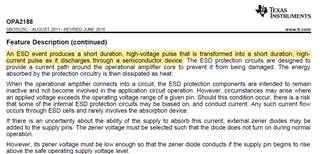
if any, Please advise me.
Thanks,
Best regards,
Lawrence
This thread has been locked.
If you have a related question, please click the "Ask a related question" button in the top right corner. The newly created question will be automatically linked to this question.
Hi, Support Team
we saw the OPA2188 of datasheet 8.3.5 Electrical Overstress
about short duration is millisecond or microsecond level?

if any, Please advise me.
Thanks,
Best regards,
Lawrence
Hi Lawrence,
An ESD event duration is on the order of nanoseconds. The OPA2188 has two ESD ratings, one for the Human Body Model (HBM) and one for the Charged Device Model (CDM). These models have slightly different durations and waveform peaks, which is why they are rated to different energy levels.

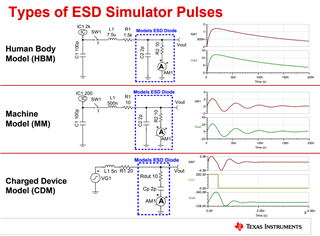
Longer duration voltage or current pulses are outside the scope of the ESD models and must be limited according to the absolute maximum ratings table.

Thanks,
Zach
Hi Ben,
There are two specifications for TI devices. One is the Electrostatic discharge (ESD) specification for short duration pulses, typically (1-100ns). The other is electrical overstress (EOS) for longer duration events.
The absolute maximum ratings are for longer duration and continuous EOS events. See the footnotes below the datasheet Abs Max table.

According to footnote 2, Input signals that can swing more than 0.5 V beyond the supply rails should be current-limited to 10 mA or less.
Is the signal shown in your image the voltage on the OPA2188 supply pin during start up and shutdown? Or is this the voltage on a signal input pin? How is this pulse being generated? Can you provide a schematic?
If this is the supply pin, the abs max supply rating is (V+ - V-) = 40V, which is not exceeded here.
If this is a signal input pin, the low side of the waveform is only (V- - 0.3V) which does not exceed the abs max of (V- -0.5V). The high side of the waveform approaches the abs max (V+ +0.5V) for a very small duration of maybe 1ns.
The ESD models are on the order of kV and amps for pulses of this duration. It is highly unlikely that this type of pulse will cause even 10mA to flow into the input terminals.
The following TI precision labs videos help clarify ESD vs EOS conditions and protection.
TIPL Electrostatic Discharge (ESD)
TIPL Electrical Overstress - Introduction
Thanks,
Zach
Hi Ben,
For EOS, we do not specify a duration as these are continuous ratings. The only guidance I can give is consistent with footnote 2 of the abs max table, Input signals that can swing more than 0.5 V beyond the supply rails should be current-limited to 10 mA or less.
If you are expecting your input signal to swing 0.5V above or below the supply rails, you must ensure that the current flowing through the input pin is less than 10mA. This can be done with current-limiting resistors, input protection diodes, or low pass filters to attenuate the fast input transients. Or a combination of these as shown in the figure below.
The following TI precision labs video details multiple overstress protection schemes: https://www.ti.com/video/4080379002001
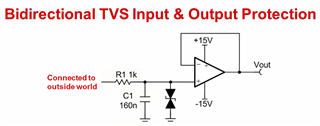
Thanks,
Zach
Hi Ben,
According to footnote 2 of the abs max table in the OPA2188 datasheet, input signals that can swing more than 0.5V beyond the supply rails must be current-limited to 10mA or less. If you do not current-limit the input pins, the device may be damaged.
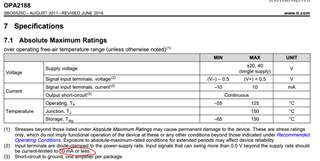
Using the input and supply voltages you described in a buffer configuration, simulation shows the magnitude of the input current is 36.4mA and the device will be damaged.
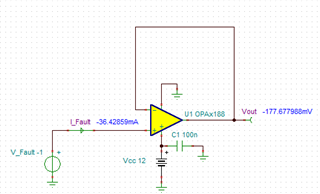
Adding a 500Ω current-limiting resistor in series with the input pin limits the fault current to a magnitude of ~1mA, and the input is protected.
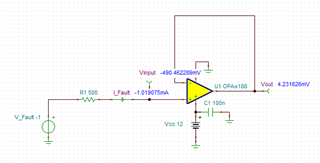
See the video links below for more detailed information on electrical overstress protection.
TIPL Electrostatic Discharge (ESD)
TIPL Electrical Overstress - Introduction
Thanks,
Zach